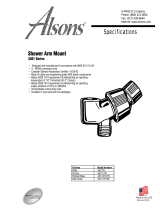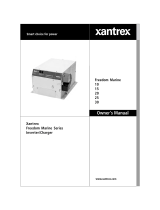Page is loading ...

PN 8401 / PN 3401 5 Position
PN 8402 / PN 3402 10 Position
PN 8403 / PN 3403 13 Position
Panel Specifi cations
Material: 0.125” 5052-H32 Aluminum Alloy
Primary Finish: Chemical Treatment per Mil Spec C-5541C
Final Panel Finish: Graphite color 2 part textured Polyurethane
Amperage Rating: All components are sized for 100 Amps of continuous
current
Voltage Rating: Panels are rated for 12 or 24 volt DC distribution.
Confi gure your panel with the supplied voltage
identifi cation labels.
Meter: DC Digital Multimeter with Alarm PN 8248
PN Inches Millimeters
Overall Dimensions: 8401/3401 5-1/4 x 7-1/2 133.40 x 190.50
8402/3402 5-1/4 x 11-1/4 133.40 x 285.80
8403/3403 10-1/2 x 7-1/2 266.70 x 190.50
Mounting Centers: 8401/3401 4-7/16 x 6-11/16 112.70 x 169.90
8402/3402 4-7/16 x 10-7/16 112.70 x 265.10
8403/3403 9-11/16 x 6-11/16 246.10 x 169.90
Applicable Standards
• American Boat and Yacht Council (ABYC) Standards and Recommended
Practices for Small Craft sections: E-1, E-3, E-9.
• United States Coast Guard 33 CFR Sub Part 1, Electrical Systems.
Marine Electrical Prod
ucts
DC Power Distribution Panel
Blue Sea Systems Inc. Phone (360) 738-8230
425 Sequoia Drive Fax (360) 734-4195
Bellingham, WA 98226 USA E-mail [email protected]
www.bluesea.com
Document 9098 Rev.F
WARNING
@ It is not possible within the scope of these instructions to fully acquaint
the installer with all the knowledge of electrical systems that may be
necessary to correctly install this product. If the installer is not
knowledgeable in electrical systems we recommend that an electrical
professional be retained to make the installation.
@ If either the panel front or back is to be exposed to water it must be
protected with a waterproof shield.
@ The panels must not be installed in explosive environments such as
gas engine rooms or battery compartments as the circuit breakers are
not ignition proof.
@ The main positive connection must be disconnected at the battery post
to avoid the possibility of a short circuit during the installation of this
distribution panel.
@ The shunt must be installed in the negative line to avoid damage to the
meter. Positive voltage applied to digital meter terminals #4 and #5 will
cause damage to the meter not covered by warranty.
Guarantee
Any Blue Sea Systems product with which a customer is not satisfi ed
may be returned for a refund or replacement at any time. Reference
Blue Sea Systems’ Digital Meter installation manual for specifi c meter
warranty information.
Useful Reference Books
Calder, Nigel, 1996: Boatowner’s Mechanical and Electrical Manual,
2nd edition, Blue Ridge Summit, PA: TAB Books, Inc.
Wing, Charlie, 1993: Boatowner’s llustrated Handbook of Wiring,
Blue Ridge Summit, PA: TAB Books, Inc.
Installation
1. Disconnect all AC and DC power
Before starting, disconnect the main positive cable from all batteries to
eliminate the possibility of a short circuit while installing the distribution
panel. Also disconnect the AC shore power cord from the boat to
eliminate the possibility of electrocution from AC wiring in the proximity
of the DC distribution panel.
2. Apply Voltage Label
All panel components are sized for 12 or 24 Volt systems. Use the
labels provided to permanently identify the system voltage and its type
(DC) as required by ABYC. Apply the appropriate voltage label to
the recessed area on the front of the panel.
3. Select mounting location and cut opening
Select a mounting location which is protected from water on the panel
front and back and is not in an area where fl ammable vapors from
propane, gas or lead acid batteries accumulate. The circuit breakers
used in marine electrical panels are not ignition protected and may
ignite such vapors.
Using the panel template provided, make a cutout in the mounting
surface where the distribution panel is to be mounted. Do not yet
fasten the panel to the mounting surface.
4. Select positive feed wire and negative return
Determine the positive feed (red) and negative return (black or yellow)
wire size by calculating the total amperage of the circuits that will be
routed through the panel. Blue Sea Systems’ electrical panels are
rated at 100 amp total capacity. The positive feed wire must be sized
for 3% voltage drop at the 100 amp panel rating or the maximum
amperage that will be routed through the panel in any particular
installation, whichever is less. It is recommended that the positive feed
wire be sized for the full panel capacity, which, in most cases, will
require at least 2 AWG wire, assuming a 10 foot wire run between the
panel and the batteries in 12 volt systems. Refer to the Wire Sizing
Chart for other situations. In the case of panels with two or more
columns of breakers, jumpers from positive bus to positive bus and
from negative bus to negative bus should be the same size as the
positive feed and the negative return wires.
Remember that the length of the circuit is the total of the positive wire
from the power source and the negative wire back to the DC Negative
Bus. Be certain that there is a fuse or circuit breaker of the correct size
protecting the positive feed wire.
5. Install shunt, negative return and positive feed
The digital meter shunt must be installed in the negative line of the
circuit whose current is to be measured. Refer to the meter installation
and operation manual prior to installing the shunt. Review the Theory
of Operation, Use, Installation Overview, Installing Shunt, Wiring
Diagram and Wire by Wire Instruction sections. Observe all warning
regarding the shunt installation.
Connect a negative return wire from the negative bus on the panel to
DC negative and ultimately the load side of the shunt. Connect a
positive feed wire from the positive bus on the panel to DC positive. Be
certain that there is a fuse or circuit breaker of the correct size
protecting the positive feed wire.
6. Install battery bank voltage monitor wires
The panel is supplied with a digital meter and switch to monitor the
voltage of three separate sources, usually the batteries. Connect a
minimum 16 AWG red wire from each source to be monitored to each
of the corresponding input wires of the switch. There should be a 1
ampere fuse in each positive wire near each source.

Installation (continued)
7. Install branch circuit wires
Determine the proper wire size for each branch circuit using the
guidelines in step 4. Verify that the standard 15 amp circuit breakers
installed in the panel are large enough for each branch circuit. Remove
and replace with a higher amperage any that are undersized. Connect
the positive (red) branch circuit wires to the load terminals of each
circuit breaker. Connect each negative (black) branch circuit wire to the
DC Negative Bus. DO NOT CONFUSE THE DC NEGATIVE BUS
WITH THE DC GROUNDING BUS.
8. Optional - install grounding system wire
The grounding wire (bare, green or green with yellow stripe and
normally non-current carrying) should not be confused with the
negative ground wire (black or yellow and normally current carrying).
In Boatowner’s Illustrated Handbook of Wiring, Charlie Wing identifi es
three purposes of DC Grounding:
1. Holding conductive housings of low voltage (under 50 volts) DC
devices at ground potential by providing a low resistance return
path for currents accidentally contacting the device cases.
2. Providing a low resistance return path for electrical current,
preventing stray currents that may cause corrosion.
3. Grounding metal electrical cases to prevent emission from inside
or absorption from outside of radio frequency noise (RFI).
ABYC requires that grounding wires be sized no smaller than one wire
size under that required for current carrying conductors supplying the
device to which the grounding wire is connected.
A full treatment of this subject is not possible within the scope of these
instructions and there is controversy surrounding the general subject of
DC bonding, of which DC grounding is a component. It is suggested
that installers not familiar with this subject consult one of the reference
books listed elsewhere in these instructions.
8. Installation of Backlight System
Connect the yellow negative wire to the panel negative bus.
To activate the label lights by the boat’s battery switch, connect the red
positive wire to the DC panel positive bus.
To activate the label lights by an independent switch or breaker, connect
the red positive wire to the load side of the switch or breaker.
9. Apply branch circuit labels and mount panel
Apply a label for each of the branch circuits from the 30 basic labels
provided. If the appropriate label is not included, the Extended Label
Set of 120 labels may be ordered from your marine supplier (PN 8039).
Individual labels are also available from Blue Sea Systems for specifi c
applications. Refer to the label order form for a complete listing of
individual labels. Fasten the panel to the mounting surface using the
panel mounting screws supplied with the panel.
10. Testing
Reconnect the main positive cable to the battery terminals and turn the
main switch on to supply power to the panel. Turn on all branch circuits
and test the voltage at the panel. Compare this voltage to the battery
terminal voltage to determine that the voltage drop is within 3%. With
all branch circuits still on, test the voltage at one device on each circuit
to determine that there is a 3% or 10% drop as is appropriate.
Note
This Blue Sea Systems electrical distribution panel is furnished with 15
amp AC/DC circuit breakers. This rating was selected to minimize the
need for removing the panel’s circuit breakers and reinstalling different
size circuit breakers. As shown in the Wire Sizing Chart included with
these instructions, even 16 AWG wire, which is the minimum wire size
recommended by ABYC, has an allowable amperage greater than 20
amps. Additionally, it would be rare to have more than 15 amps of current
fl owing in any one circuit. Therefore, 15 amp circuit breakers will satisfy
the vast majority of marine circuit protection situations.
Optional Branch LED’s
This panel is supplied with LED’s pre-installed in all optional branch
positions. For future expansion of the panel remove the positive leg of
the LED from the negative bus and connect it to the load side of the
corresponding branch circuit breaker.
The Purpose of a Panel
There are fi ve purposes of a marine electrical panel:
• Power distribution
• Circuit (wire) protection
• Circuit ON/OFF switching
• Metering of voltage and amperage (In panels with meters)
• Condition Indication (circuit energized)
Wiring Diagram
DC Power Distribution Panel
with DC Multimeter
(PN 8403 / PN 3403 shown for reference)
/

